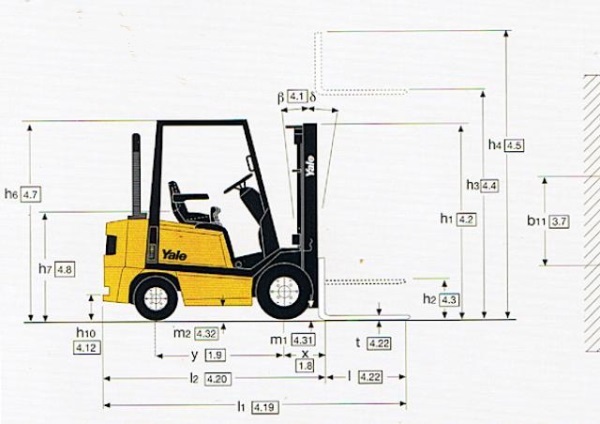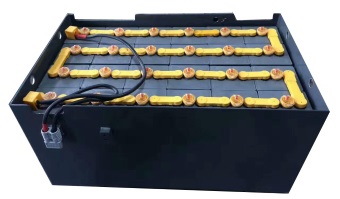Forklift Technical Information
The largest forklift operator training website in the world
![]()
![]()
Forklift Truck Traction Batteries
 Lead-acid batteries contain sulfuric acid and only trained and authorized personnel should handle them. When talking about lead-acid batteries, people usually call sulfuric acid "battery acid" or the "electrolyte". An electrolyte is a general term used to describe a non-metallic substance like acids such as sulfuric acid or salts that can conduct electricity when dissolved in water.
Lead-acid batteries contain sulfuric acid and only trained and authorized personnel should handle them. When talking about lead-acid batteries, people usually call sulfuric acid "battery acid" or the "electrolyte". An electrolyte is a general term used to describe a non-metallic substance like acids such as sulfuric acid or salts that can conduct electricity when dissolved in water.
Lead-acid batteries can produce explosive mixtures of hydrogen and oxygen gases when they are being charged.
-
Charge batteries only in approved, ventilated battery-charging areas.
-
Install a safety shower and an eyewash station in a battery-charging area.
-
Wear splash-proof goggles and protective clothing (gloves and aprons). A face shield may also be necessary when handling sulfuric acid in an open system.
-
Do not store acid in hot locations or in direct sunlight.
-
Pour concentrated acid slowly into water: do not add water into acid. Use nonmetallic containers and funnels. (Important: You DO add water to acid when simply topping up batteries).
-
Use extreme care to avoid spilling or splashing the sulfuric acid solution. It can destroy clothing and burn the eyes and skin.
-
Use an eyewash station if the sulfuric acid solution is splashed into the eye.
-
Neutralize spilled or splashed sulfuric acid solution with a baking soda solution, and rinse the spill area with clean water.
What to do if someone gets sulfuric acid on their skin
- Avoid direct contact. Wear chemical-resistant protective clothing, if necessary.
- As quickly as possible, flush the contaminated area with lukewarm, gently flowing water for at least 20-30 minutes, by the clock.
- If irritation persists, repeat flushing. DO NOT INTERRUPT FLUSHING . If necessary, keep emergency vehicle waiting.
- Under running water, remove contaminated clothing, shoes and other leather goods (e.g., watchbands, belts)
- Transport the victim to an emergency care facility immediately.
- Discard contaminated clothing, shoes and leather goods
- Avoid direct contact. Wear chemical-resistant gloves, if necessary.
- Immediately flush the contaminated eye(s) with lukewarm, gently flowing water for at least 20-30 minutes, by the clock, while holding the eyelid(s) open. Neutral saline solution may be used as soon as it is available.
- DO NOT INTERRUPT FLUSHING . If necessary, keep the emergency vehicle waiting.
- Take care not to rinse contaminated water into the unaffected eye or onto the face.
- If irritation persists, repeat flushing.
- Quickly transport the victim to an emergency care facility.
Dangers of exploding batteries
The charging of lead-acid batteries can be hazardous. When batteries are being recharged, they generate hydrogen gas that is explosive in certain concentrations in air (the flammability or explosive limits are 4.1% to 72% hydrogen in air). The spark-retarding vents help slow the rate of release of hydrogen, but the escaping hydrogen may form an explosive atmosphere around the battery if ventilation is poor. The ventilation system should be designed to provide an adequate amount of fresh air for the number of batteries being charged. This is essential to prevent an explosion.
- Always keep sparks, flames, burning cigarettes, and other sources of ignition away from the battery recharging area.
- Wear protective eye wear when working near batteries.
- Do not break "live" circuits at the terminals of batteries.
Re - charging batteries
- Check the electrolyte level before recharging. If the battery has been outside in cold weather, make sure that the battery is not frozen before recharging it.
- If the electrolyte is covering the top of the plates, do not add more water. Recheck the fluid level after the battery has been recharged. If water is added, use distilled water, not tap water.
- When vent plugs may need adjustment, follow manufacturers' instructions carefully.
- If the battery has sealed vents, do not recharge the battery with a current greater than 25 amps.
- To reduce the possibility of explosions, follow the recommendations of the charger manufacturer for attaching and removing cables and for operating the equipment properly. Generally, this includes unplugging or turning off the charger before connecting or disconnecting the clamp connections. Carefully attach the clamps to the battery with the proper polarity (positive [+] clamp, usually red, to the positive terminal and negative (-) clamp, usually black, to the negative terminal).
- Ensure that area is ventilated when the batteries are being charged.
- If the battery becomes hot or if the electrolyte spits out from the vent, turn off the charger temporarily. Resume recharging using a lower current or charging rate.
Servicing batteries. Qualified personnel only!
- Keep metal tools and jewelry away from the battery.
- Inspect for defective cables, loose connections, corroded cable connectors or battery terminals, cracked cases or covers, loose hold-down clamps and deformed or loose terminal posts.
- Replace worn or unserviceable parts.
- Check the state of charge of non-sealed and sealed batteries with an accurate digital voltmeter while the engine is not running and lights and other electrically-powered equipment are turned off. Also check the electrolyte levels and specific gravity in each cell of non-sealed batteries. Follow the battery manufacturer's recommendations about when to recharge or replace batteries.
- Tighten cable clamp nuts with the proper size wrench. Avoid subjecting battery terminals to excessive twisting forces.
- Use a cable puller to remove a cable clamp from the battery terminal.
- Remove corrosion on the terminal posts, hold-down tray and hold-down parts.
- Use a tapered brush to clean battery terminals and the cable clamps.
- Wash and clean the battery, battery terminals, and case or tray with water. The corrosive acid can be neutralized by brushing on some baking soda (sodium bicarbonate) solution. If the solution does not bubble, the acid is probably neutralized. Rinse the battery with water to remove the baking soda solution.
- To prevent electric shocks, never touch or come in contact with both terminals at the same time. If baking soda solution is applied with a cloth, remember that these solutions can conduct electricity.
- When battery cables are removed, ensure that they are clearly marked "positive" and "negative" so that they are reconnected with the correct polarity.
- Use a battery carrier to lift a battery.
- Use a self-leveling filler that automatically fills the battery to a predetermined level. Never fill battery cells above the level indicator.
As a fork lift operator or instructor you would not normally be involved in maintaining batteries to the extent that is listed on this page. The information is for reference only. If in doubt, leave it to a qualified battery service engineer. Batteries are DANGEROUS when misused.